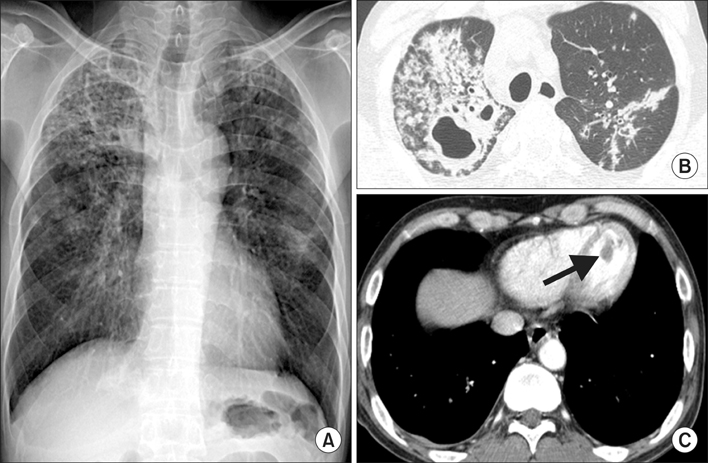Tuberc Respir Dis.
2014 Jul;77(1):24-27.
Takotsubo Cardiomyopathy Caused by Pulmonary Tuberculosis: A Case Report
- Affiliations
-
- 1Division of Pulmonology, Critical Care and Sleep Medicine, Department of Internal Medicine, The Catholic University of Korea College of Medicine, Seoul, Korea. mdlee@gmail.com
Abstract
- Takotsubo cardiomyopathy (TTC) is defined as a reversible, acute ventricular dysfunction without any evidence of coronary artery obstruction. There have been reports of TTC caused by emotional or physical stress, drug use, hormone imbalance, or medical conditions such as pulmonary disease, sepsis, and trauma, but a relationship between TTC and pulmonary tuberculosis has not previously been reported. From our knowledge, this is the first report of TTC caused by pulmonary tuberculosis.
MeSH Terms
Figure
Reference
-
1. Bossone E, Savarese G, Ferrara F, Citro R, Mosca S, Musella F, et al. Takotsubo cardiomyopathy: overview. Heart Fail Clin. 2013; 9:249–266.2. Tranter MH, Wright PT, Sikkel MB, Lyon AR. Takotsubo cardiomyopathy: the pathophysiology. Heart Fail Clin. 2013; 9:187–196.3. Prasad A, Lerman A, Rihal CS. Apical ballooning syndrome (Tako-Tsubo or stress cardiomyopathy): a mimic of acute myocardial infarction. Am Heart J. 2008; 155:408–417.4. Miki K, Maekura R, Hiraga T, Hashimoto H, Kitada S, Miki M, et al. Exertional dyspnea-related acidotic and sympathetic responses in patients with sequelae of pulmonary tuberculosis. J Physiol Sci. 2010; 60:187–193.5. Watanabe E, Ogawa K, Ban M, Satake T. Sympathetic nervous systems in chronic hypoxic states from pulmonary tuberculosis: a clinical study on plasma norepinephrine and cyclic AMP levels. Jpn J Med. 1981; 20:180–187.6. Finsterer J, Stollberger C, Pulgram T. Paraneoplastic takotsubo syndrome with ventricular thrombus and stroke. Herz. 2013; 11. 09. [Epub]. http://dx.doi.org/10.1007/s00059-013-3956-2.7. Shim IK, Kim BJ, Kim H, Lee JW, Cha TJ, Heo JH. A case of persistent apical ballooning complicated by apical thrombus in takotsubo cardiomyopathy of systemic lupus erythematosus patient. J Cardiovasc Ultrasound. 2013; 21:137–139.8. Celik M, Yalcinkaya E, Yuksel UC, Celik T, Iyisoy A. Multiple foci of infarction secondary to giant left ventricular thrombus in a patient with takotsubo cardiomyopathy. Oman Med J. 2013; 28:294.9. Lee PH, Song JK, Park IK, Sun BJ, Lee SG, Yim JH, et al. Takotsubo cardiomyopathy: a case of persistent apical ballooning complicated by an apical mural thrombus. Korean J Intern Med. 2011; 26:455–459.10. Tobar R, Rotzak R, Rozenman Y. Apical thrombus associated with Takotsubo cardiomyopathy in a young woman. Echocardiography. 2009; 26:575–580.11. Azzarelli S, Galassi AR, Amico F, Giacoppo M, Argentino V, Giordano G, et al. Apical thrombus in a patient with takotsubo cardiomyopathy. J Cardiovasc Med (Hagerstown). 2008; 9:831–833.12. Mitsuma W, Kodama M, Ito M, Kimura S, Tanaka K, Hoyano M, et al. Thromboembolism in Takotsubo cardiomyopathy. Int J Cardiol. 2010; 139:98–100.13. Anfossi G, Trovati M. Role of catecholamines in platelet function: pathophysiological and clinical significance. Eur J Clin Invest. 1996; 26:353–370.
- Full Text Links
- Actions
-
Cited
- CITED
-
- Close
- Share
- Similar articles
-
- A Case of Reversal of Takotsubo Cardiomyopathy in Patient with Pheochromocytoma
- Takotsubo Cardiomyopathy Associated with Severe Hypocalcemia Secondary to Idiopathic Hypoparathyroidism
- Takotsubo Cardiomyopathy Induced after Postoperative ICU Care: Case Reports
- Takotsubo cardiomyopathy during ambulatory anesthesia for bladder hydrodistension therapy: A case report
- Takotsubo-Like Severe Left Ventricular Dysfunction After Cesarean Delivery in a 28-Year Old Woman



